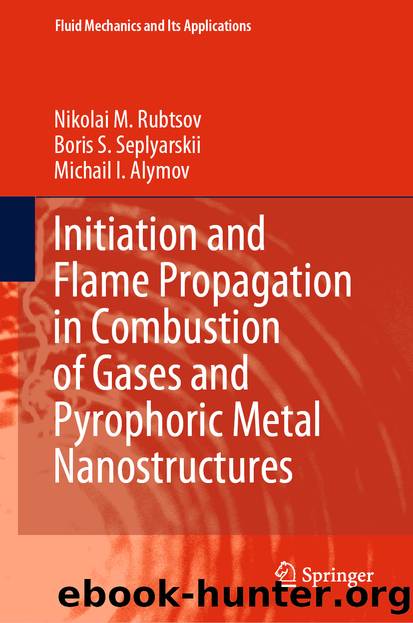Initiation and Flame Propagation in Combustion of Gases and Pyrophoric Metal Nanostructures by Nikolai M. Rubtsov & Boris S. Seplyarskii & Michail I. Alymov

Author:Nikolai M. Rubtsov & Boris S. Seplyarskii & Michail I. Alymov
Language: eng
Format: epub
ISBN: 9783030578916
Publisher: Springer International Publishing
A two-dimensional planar problem was examined. Characteristic scales of the process were chosen as follows: t0 = 1/(k10 [H2]0), x0 = (D3/k10[H2]0)1/2, U0 = x0/t0 = (D3k10[H2]0)1/2 (the scales of time, length and velocity correspondingly, D3 is the diffusivity of H2). We determine the dimensionless variables and parameters Ï = t/t0, ξ = x/x0, η = y/y0, Ï = U/U0, Yi = [concentration of ith component]/[H2]0, δi = Di/D3 (Diâdiffusivity of ith component). Velocity and coordinates of the propagating flame front were designated in terms of the diffusivity of H2 (D3): Ï = U/(D3 k10[H2]0)1/2, ξ = x/(D3/k10[H2]0)1/2, η = y/(D3/k10[H2]0)1/2; here, U, x and y are corresponding dimensional values, k10âthe pre-exponential factor of the reaction (1). Diffusivities (Di/D3, i = 0â6) δ0, δ1, δ2, δ3 = 1, δ4, δ5, δ6 in H2 + O2 mixture refer to OH, O, H, H2, O2, HO2, H2O2 correspondingly. The set of reactionâdiffusion equations for the above reaction mechanism takes the form (m, n = 0â6 refer to reacting particles OH, O, H, H2, O2, HO2, H2O2, respectively):
Download
This site does not store any files on its server. We only index and link to content provided by other sites. Please contact the content providers to delete copyright contents if any and email us, we'll remove relevant links or contents immediately.
Whiskies Galore by Ian Buxton(40326)
Introduction to Aircraft Design (Cambridge Aerospace Series) by John P. Fielding(32337)
Small Unmanned Fixed-wing Aircraft Design by Andrew J. Keane Andras Sobester James P. Scanlan & András Sóbester & James P. Scanlan(32141)
Craft Beer for the Homebrewer by Michael Agnew(17445)
Turbulence by E. J. Noyes(7037)
The Complete Stick Figure Physics Tutorials by Allen Sarah(6637)
Kaplan MCAT General Chemistry Review by Kaplan(6053)
The Thirst by Nesbo Jo(5783)
Bad Blood by John Carreyrou(5766)
Learning SQL by Alan Beaulieu(5407)
Weapons of Math Destruction by Cathy O'Neil(5034)
Man-made Catastrophes and Risk Information Concealment by Dmitry Chernov & Didier Sornette(4734)
iGen by Jean M. Twenge(4702)
Digital Minimalism by Cal Newport;(4529)
Life 3.0: Being Human in the Age of Artificial Intelligence by Tegmark Max(4502)
Audition by Ryu Murakami(4097)
1,001 ASVAB Practice Questions For Dummies by Powers Rod(4036)
Electronic Devices & Circuits by Jacob Millman & Christos C. Halkias(4024)
Pale Blue Dot by Carl Sagan(4001)
